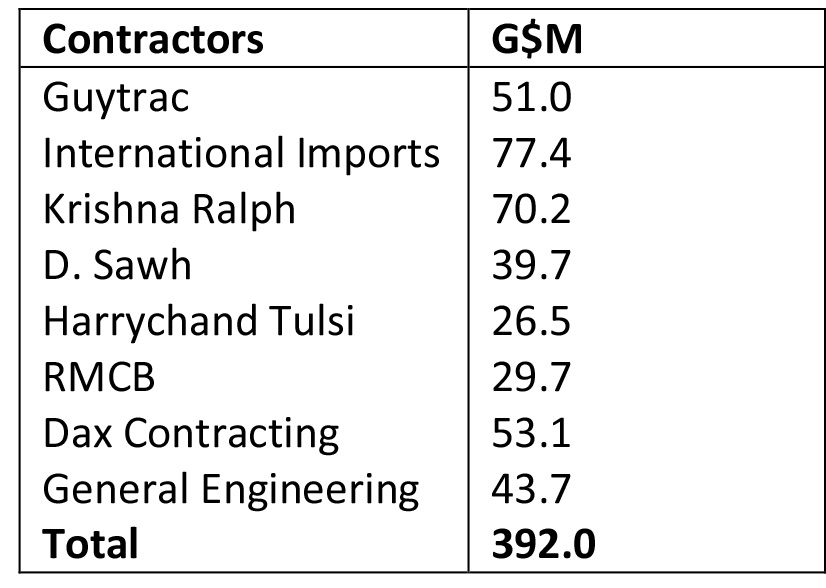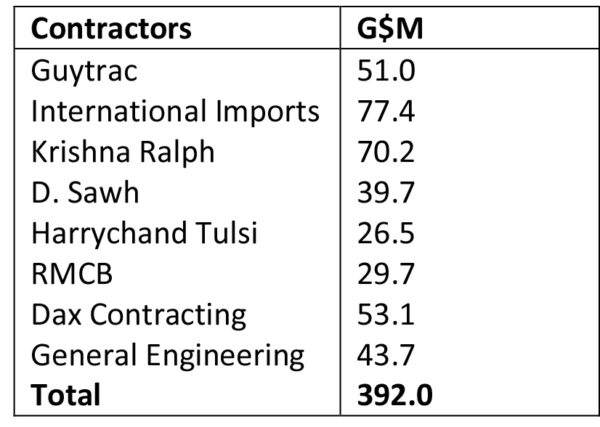The National Drainage and Irrigation Authority (NDIA) had no fixed asset register despite having billions of dollars in equipment and management was unable to explain how it spent $1.8b in repairs over 2011-2014.
These findings were contained in a scathing report by Nigel Hinds Financial Services which was transmitted to the Ministry of Finance on November 30th last year but only released yesterday.
The audit report said that the $1.8b in repairs was recorded despite the fact that new machinery and equipment acquired during the same period exceeded 50% of the listed machinery and equipment of NDIA.
The report explains that based on contracts examined for years 2012 to June 2015, which amounted to $587 Million out of $896 Million expended it was noted that “93 % of the amount spent was on repairs and rehabilitation of machinery and equipment and 7% on spares and supplies which suggests a preference for external repairs rather than for repairs to be done in house.”
During interviews Avinash Singh, Head of the Mechanical Division, is reported as stating that NDIA was not equipped to handle its own repairs because of the absence of mechanics and other resources.
Eight contractors are recorded as having been awarded 72% or $392 Million of contracts to the tune of $547 Million which were awarded to 52 contractors for repairs and maintenance.
The report notes that one of the contractors Harrychand Tulsi also trades as General Engineering thus this individual was awarded a total of $79.6M worth of the contracted work.
Further, out of the $39.6m awarded for procurement of spares and supplies 43% or $17.1m was awarded to Deonarine Sugrim and Guytrac. Deonarine Sugrim is the owner of Guytrac.
Also concerning was the fact that parts removed from machinery and equipment were not available for inspection primarily in Lusignan and Whim, Corentyne.
“It was difficult to reconcile parts which were available to particular work orders and machinery and equipment,” the report said adding that “vague descriptions were written on the work orders.”
According to the report the descriptions written were as follows, “provide tools, materials and labour to repair draglines”. This was noted in several cases with huge invoice values attached. It was impossible to determine the works done in the absence of specific details on the work orders.
Additionally, minutes of the Board Meeting showed members were not told at any point of the massive repair costs or provided with cost reports for discussion and decision making as to the level of expenditures.
Auditors identified a lack of expertise to prepare targeted management accounts in the Finance Department as being responsible for the failure to highlight the unusually high level of expenditures.
The Head of the Mechanical Division who revealed that he was aware of the high cost of repair works done on machinery and equipment is noted as agreeing that the sums spent did not make financial sense and should be halted immediately.
“There were several memos exchanged between the CEO, Mr. Lionel Wordsworth and Mr. Avinash Singh on this matter but little or no action has been taken to date to address the high repairs costs,” the report states.
A memo was also found to have been exchanged between Wordsworth and Singh in April of 2012 on the absence of a clear work programme for his department “but it appears again that little or no action was taken other than Mr. Singh continued to note the lack of or insufficient resources to manage his department efficiently and effectively.”
The audit report said that NDIA had never maintained a Fixed Asset Register to record acquisition date, purchase cost, estimated life of fixed asset etc.
“This reckless omission for an entity that has over $4 Billion in Fixed Assets is incomprehensible”, the audit report said pointing out that the Auditor General reports for 2012 and 2013 had repeatedly said that NDIA failed to maintain records for fixed assets.
The Hinds audit report pointed out that the Japan International Cooperation Agency had handed over six excavators in 2013 but there was no evidence that they were accounted for by the NDIA. It also noted that the NDIA functioned without a qualified accountant.
Crucially, the report addressed the question of whether there could be a successful prosecution for its findings.
“There were many breaches of operating procedures, with weak and non-functioning internal controls across multiple transactions processed.
“In addition, the annual external audit done by the Audit Office provides limited coverage of the activities of NDIA since NDIA audit is incorporated as part of the audit of MOA.
“Our review was limited to the examination of records made available to us, along with interviews of various management personnel. We identified red flags particularly in the areas mentioned earlier which could lead to several improprieties but we were unable to gather the evidence to support a successful prosecution against any management personnel at this time.
“In many instances corruption is an off the book fraud that requires the use of white collar investigative methodologies such as Net Worth Computation, Asset Analysis or expenditure approaches to measure assets acquired against earnings.
“Such techniques will require access to personal bank accounts and records of property owned by individuals being investigated to reveal indication of unexplained wealth. These matters are outside the Terms of Reference of this forensic audit.
“We are of the considered opinion that the failure of the Board of Directors and senior management to provide good governance led to a loss of confidence in the governance and management of NDIA.
“It is therefore the task of the new Board of Directors to use this Report as a basis to do further work in the troubled areas to improve the quality of management at NDIA”, the audit report said.
Table showing the distribution of $392Million worth of NDIA repair contracts.







